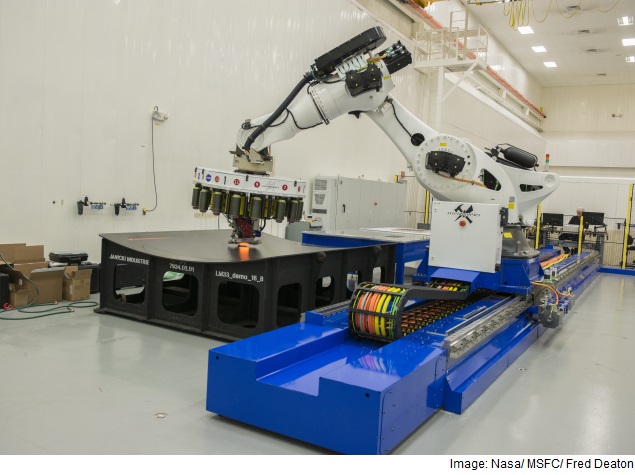Nasa Robot Building Biggest Rocket Parts for Mars Mission
Advertisement

A giant robot at the Nasa facility is helping engineers build the biggest, lightweight composite rocket parts so far made for future space vehicles to deeper missions including Mars.
Mounted on a 40-foot-long track at the composites technology centre of Nasa's Marshall Space Flight Center in Huntsville, Alabama, the robot's head has 16 spools of composite fibre tape that it releases in precise patterns to make both small and large objects.
To make large composite structures, the robot travels on the track and a head at the end of its 21-foot robot arm articulates in multiple directions.
As the fibres are released, they are heated so that they adhere to various surfaces. The head can be changed out for different projects.
"This new robotic manufacturing system provides modern technology to develop low-cost and high-speed manufacturing processes for making large composite rocket structures," said Preston Jones, deputy director of Marshall's engineering directorate, in a statement.
Advertisement
"We will build and test these structures to determine if they are a good fit for space vehicles that will carry humans on exploration missions to Mars and other places," he added.
It takes a myriad of different materials to build a space vehicle like Nasa's new Space Launch System (SLS), a heavy-lift rocket designed to take explorers on deep space missions including Mars.
Advertisement
The lighter the rocket, the more payload - crew, science instruments, food, equipment and habitats - the rocket can carry to space.
Lightweight composites have the potential to increase the amount of payload that can be carried by a rocket along with lowering its total production cost.
Advertisement
"The robot will build structures larger than eight metres (26 feet) in diameter, some of the largest composite structures ever constructed for space vehicles," informed Justin Jackson, Marshall materials engineer who installed and checked out the robot.
Composite manufacturing has advanced tremendously in the last few years.
Nasa is using this industrial automated fibre placement tool in new ways to advance space exploration.
"Marshall's investment in this robot will help mature composites manufacturing technology that may lead to more affordable space vehicles," Jackson noted.
These new robotic fibre placement tools are game changers because they can drastically reduce the cost and improve the quality of large space structures, the statement said.
For the latest tech news and reviews, follow Gadgets 360 on X, Facebook, WhatsApp, Threads and Google News. For the latest videos on gadgets and tech, subscribe to our YouTube channel. If you want to know everything about top influencers, follow our in-house Who'sThat360 on Instagram and YouTube.
Advertisement
